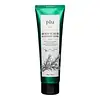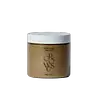What's inside
What's inside
 Key Ingredients
Key Ingredients

 Benefits
Benefits

 Concerns
Concerns

 Ingredients Side-by-side
Ingredients Side-by-side

Disodium Laureth Sulfosuccinate
CleansingJuglans Regia Shell Powder
AbrasiveCocamidopropyl Betaine
CleansingCocamide DEA
EmulsifyingGlycerin
HumectantSodium Chloride
MaskingPunica Granatum Fruit Extract
AntioxidantHoney Extract
HumectantRosa Hybrid Flower Extract
Skin ConditioningPrunus Serrulata Flower Extract
Skin ConditioningChrysanthemum Morifolium Flower Extract
Skin ConditioningCocamide Methyl Mea
Parfum
MaskingTriethanolamine
BufferingLaureth-9
EmulsifyingRosmarinus Officinalis Extract
AntimicrobialChamomilla Recutita Flower/Leaf Extract
AntimicrobialLavandula Angustifolia Extract
Skin ConditioningCentella Asiatica Extract
CleansingMonarda Didyma Leaf Extract
Skin ConditioningCarbomer
Emulsion StabilisingSodium Hyaluronate
HumectantDisodium Lauroyl Glutamate
CleansingAscorbic Acid
AntioxidantPolyquaternium-10
Phenoxyethanol
PreservativeDisodium EDTA
Ethylhexylglycerin
Skin ConditioningDisodium Laureth Sulfosuccinate, Juglans Regia Shell Powder, Cocamidopropyl Betaine, Cocamide DEA, Glycerin, Sodium Chloride, Punica Granatum Fruit Extract, Honey Extract, Rosa Hybrid Flower Extract, Prunus Serrulata Flower Extract, Chrysanthemum Morifolium Flower Extract, Cocamide Methyl Mea, Parfum, Triethanolamine, Laureth-9, Rosmarinus Officinalis Extract, Chamomilla Recutita Flower/Leaf Extract, Lavandula Angustifolia Extract, Centella Asiatica Extract, Monarda Didyma Leaf Extract, Carbomer, Sodium Hyaluronate, Disodium Lauroyl Glutamate, Ascorbic Acid, Polyquaternium-10, Phenoxyethanol, Disodium EDTA, Ethylhexylglycerin
Sodium Chloride
MaskingWater
Skin ConditioningSodium Lauroyl Methyl Isethionate
CleansingGlycerin
HumectantCoco-Betaine
CleansingGlycol Distearate
EmollientSodium Methyl Cocoyl Taurate
CleansingParfum
MaskingSalicylic Acid
MaskingSodium Methyl Isethionate
EmulsifyingLauric Acid
CleansingCaprylyl Glycol
EmollientCaramel
Cosmetic ColorantMenthol
MaskingDipropylene Glycol
HumectantSodium Hydroxide
BufferingLaminaria Japonica Powder
Skin ConditioningGlyceryl Caprylate
EmollientDisodium EDTA
Sea Water
HumectantSea Salt
AbrasiveButylene Glycol
Humectant1,2-Hexanediol
Skin ConditioningSpirulina Platensis Extract
Skin ProtectingUndaria Pinnatifida Extract
Skin ConditioningLaminaria Japonica Extract
Skin ProtectingEnteromorpha Compressa Extract
Skin ProtectingGelidium Cartilagineum Extract
Skin ProtectingSodium Chloride, Water, Sodium Lauroyl Methyl Isethionate, Glycerin, Coco-Betaine, Glycol Distearate, Sodium Methyl Cocoyl Taurate, Parfum, Salicylic Acid, Sodium Methyl Isethionate, Lauric Acid, Caprylyl Glycol, Caramel, Menthol, Dipropylene Glycol, Sodium Hydroxide, Laminaria Japonica Powder, Glyceryl Caprylate, Disodium EDTA, Sea Water, Sea Salt, Butylene Glycol, 1,2-Hexanediol, Spirulina Platensis Extract, Undaria Pinnatifida Extract, Laminaria Japonica Extract, Enteromorpha Compressa Extract, Gelidium Cartilagineum Extract
Alternatives
Ingredients Explained
These ingredients are found in both products.
Ingredients higher up in an ingredient list are typically present in a larger amount.
Disodium EDTA plays a role in making products more stable by aiding other preservatives.
It is a chelating agent, meaning it neutralizes metal ions that may be found in a product.
Disodium EDTA is a salt of edetic acid and is found to be safe in cosmetic ingredients.
Learn more about Disodium EDTAGlycerin is already naturally found in your skin. It helps moisturize and protect your skin.
A study from 2016 found glycerin to be more effective as a humectant than AHAs and hyaluronic acid.
As a humectant, it helps the skin stay hydrated by pulling moisture to your skin. The low molecular weight of glycerin allows it to pull moisture into the deeper layers of your skin.
Hydrated skin improves your skin barrier; Your skin barrier helps protect against irritants and bacteria.
Glycerin has also been found to have antimicrobial and antiviral properties. Due to these properties, glycerin is often used in wound and burn treatments.
In cosmetics, glycerin is usually derived from plants such as soybean or palm. However, it can also be sourced from animals, such as tallow or animal fat.
This ingredient is organic, colorless, odorless, and non-toxic.
Glycerin is the name for this ingredient in American English. British English uses Glycerol/Glycerine.
Learn more about GlycerinParfum is a catch-all term for an ingredient or more that is used to give a scent to products.
Also called "fragrance", this ingredient can be a blend of hundreds of chemicals or plant oils. This means every product with "fragrance" or "parfum" in the ingredients list is a different mixture.
For instance, Habanolide is a proprietary trade name for a specific aroma chemical. When used as a fragrance ingredient in cosmetics, most aroma chemicals fall under the broad labeling category of “FRAGRANCE” or “PARFUM” according to EU and US regulations.
The term 'parfum' or 'fragrance' is not regulated in many countries. In many cases, it is up to the brand to define this term.
For instance, many brands choose to label themselves as "fragrance-free" because they are not using synthetic fragrances. However, their products may still contain ingredients such as essential oils that are considered a fragrance by INCI standards.
One example is Calendula flower extract. Calendula is an essential oil that still imparts a scent or 'fragrance'.
Depending on the blend, the ingredients in the mixture can cause allergies and sensitivities on the skin. Some ingredients that are known EU allergens include linalool and citronellol.
Parfum can also be used to mask or cover an unpleasant scent.
The bottom line is: not all fragrances/parfum/ingredients are created equally. If you are worried about fragrances, we recommend taking a closer look at an ingredient. And of course, we always recommend speaking with a professional.
Learn more about ParfumChances are, you eat sodium chloride every day. Sodium Chloride is also known as table salt.
This ingredient has many purposes in skincare: thickener, emulsifier, and exfoliator.
You'll most likely find this ingredient in cleansers where it is used to create a gel-like texture. As an emulsifier, it also prevents ingredients from separating.
There is much debate on whether this ingredient is comedogenic. The short answer - comedogenic ratings don't tell the whole story. Learn more about comegodenic ratings here.
The concensus about this ingredient causing acne seems to be divided. Research is needed to understand if this ingredient does cause acne.
Scrubs may use salt as the primary exfoliating ingredient.
Learn more about Sodium Chloride